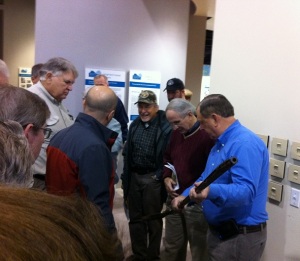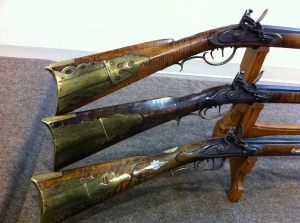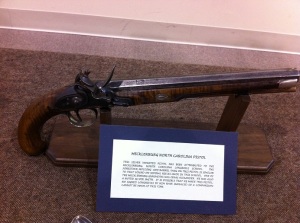Weapons hold a special place in all cultures. The tradition of a special bond between the weapon and its owner is one we see often in history, folklore, and literature. Think of the samurai’s katana, Thor’s Mjölnir, Arthur’s Excalibur, Bilbo’s Sting, and Davy Crockett’s Ol’ Betsy.
This morning, I attended a presentation at the Charlotte Museum of History on the Mecklenburg Longrifle, a fine and highly sought-after weapon produced here in the Charlotte, North Carolina, area in the 18th and early 19th centuries. Michael Briggs, the author of The Longrifle Makers of Guilford County and The Longrifle Makers of Forsyth County & Davidson County, displayed some breathtaking pieces from his personal collection, and generously identified and discussed longrifles that audience members brought in.

Author Michael Briggs examining a longrifle.
North Carolina had nine different schools, or regional styles, of longrifles. Those distinctive styles were the outgrowth of the culture of the settler population. The predominant Scots-Irish and German population in the North Carolina Piedmont and Appalachian Mountains brought their woodworking, silversmithing, and metalworking traditions together to craft elegant and vital weapons for life on the frontier.
Click to enlarge
What most fascinated me was the extraordinary detail and ornamentation gunsmiths imparted to their creations. These longrifles are truly works of art. When the Museum of Early Southern Decorative Arts featured a longrifle exhibit, the magazine ad announcing it featured a photo showing the gorgeous detail of an engraved silver stock with the motto “I’ve stopped people in their tracks without firing a shot.”
This pistol was the work of Zenas Alexander, who was also a noted silversmith working in Charlotte in the early 19th century. When Michael Briggs showed a photo of a silver pitcher by Alexander, someone behind me muttered, “Guns and tea sets. What a helluva combination!”
But I think there’s no disparity at all in Alexander’s dual careers. The longrifle was more than just a tool. It was necessary for hunting and self-defense. With it, a settler possessed security and independence. For the settlers on the North Carolina frontier, the longrifle was life itself. So the ornamentation wasn’t just an afterthought; it personalized the weapon. As the Museum of Early Southern Decorative Arts said, these guns were stunning works of art. And yes, they were weapons, too. Something that essential to life possesses a beauty of its own, and I think the extra effort Zenas Alexander and the other gunsmiths spent engraving their creations was their way of expressing the natural awe that the future owners of their creations would feel.
As John O’Donohue once said, “The human soul is hungry for beauty; we seek it everywhere – in landscape, music, art, clothes, furniture, gardening, companionship, love, religion, and in ourselves.” I’d add that beauty can be found where we often least expect it — and that makes it all the more compelling.


Reblogged this on Thoughts on Fantasy and commented:
An interesting post about antique rifles over at mctuggle.com – it seems it wasn’t only sword-smiths that put effort into intricately adorning and crafting their weapons of choice. If medieval fantasy lovingly describes the inscriptions and ornamentation on blade hilts, I can imagine more contemporary fantasy describing the intricate woodwork and metalwork on some of these.
LikeLike
Nicola,
Yes, there’s definitely a common pattern within many real-world and imagined cultures regarding weaponry. The root principle is the status of the weapon as an instrument of survival and independence. That’s about as basic as it gets.
Thanks for re-blogging!
LikeLike
Great post. Colonial history is a favorite of mine. I think it would be a perfect setting for fantasy lit.
LikeLike
Gangee,
Thanks. I’m sure there are others, but the only fantasy work based on colonial history that comes to mind is Robert E. Howard’s Beyond the Black RIver, where the Picts stand in for Indians.
LikeLike
A beautiful tribute to some beautiful weapons!
LikeLike
Sam Drucket,
I appreciate that. You really have to see them in real life to appreciate them. Or buy Michael Brigg’s book.
http://blackpowderweb.com/c-michael-briggs
LikeLike
Reblogged this on Ipuna Black and commented:
I’m the last person that knows anything about guns, but I loved the John O’Donohue quote and what M.C. Tuggle added. I never thought about a gun being a piece of art…an expression.
LikeLike
I LOVE John O’Donohue and was so sad at his passing. A truly remarkable person with amazing insight. Your blog made me think about the difference between weapons as a work of art and weapons as a means of death. There’s no art whatsoever in the weapons used today on the streets and in the wars. They mean something very different. Where did we lose that, I wonder…
LikeLike
calensariel,
I first heard him on Krista Tippett’s On Being. I was floored. Anam Cara was bought the next day, and I still love reading it.
WMDs, from poison gas to nukes, are an affront to civilization itself. I am stirred to tears by personal acts of courage but believe modern industrialized war is obscene.
LikeLike